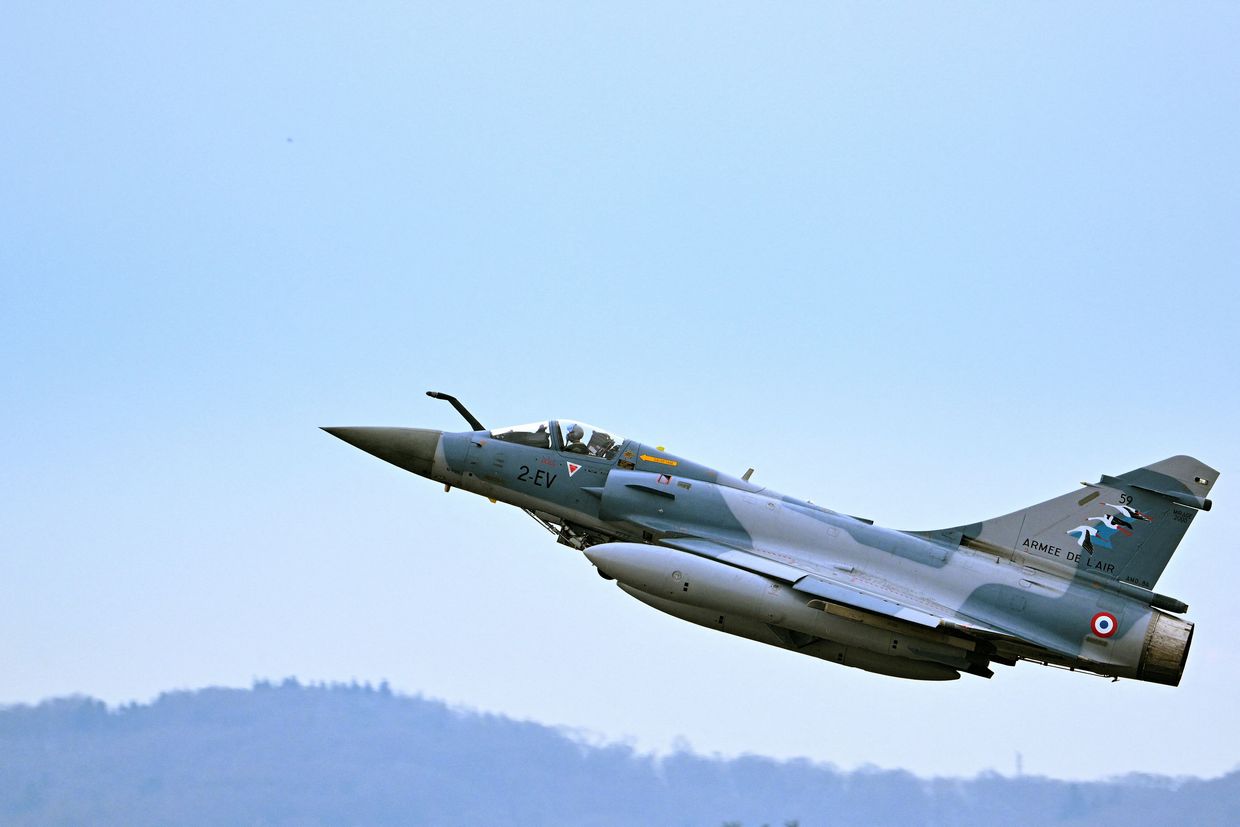
Who needs warships when you’ve got drones? Russia loses control over Black Sea
Illustrative purposes only: A Ukrainian serviceman of the Main Directorate of Intelligence of the Ukrainian Defense Ministry controls a Magura naval drone during a demonstration for journalists at an undisclosed location in Ukraine on April 11, 2024, amid the Russian invasion of Ukraine. (Genya Savilov/AFP via Getty Images)
The view from the camera skims over the water, low and predatory. Dodging left and right between rows of white splashes, it sidles up to the aft of the looming gray hull. A shape appears to scramble across the deck of the Russian corvette before the feed cuts off.
The next naval drone behind it records a brilliant explosion and a rising grayscale fireball. By the time it reaches the corvette Ivanovets, the hull looks pretty mangled. There appear to be no more white splashes from the vessel to worry about. Just as its long-range missiles will threaten Ukrainian cities no more.
This February attack, in which a big, expensive warship was taken down by Ukraine’s cheap, remote-controlled pack hunter drones like the Magura, is just one of many illustrations of how the full-scale war has been, in a word, asymmetrical. While Russians have made gains on land, they may as well have lost their dominance and security in the Black Sea for the foreseeable future.
Ukraine’s special services aren’t slowing down. In June, they sank a Saturn-type tugboat and struck multiple speedboats at once. Their weapon of choice is the combined drone attack — the David to Russia’s Goliath, and now the backbone of Ukraine’s Black Sea strategy.
“The Russian Navy's sphere of influence in the Black Sea has been significantly reduced, and the whole world can see this today,” Andrii Yusov, spokesperson for Ukraine's Defense Intelligence (HUR) told the Kyiv Independent.
Russia began the war with a formidable Black Sea fleet and all the Ukrainian ports in Crimea it seized in 2014, including the Ukrainian vessels that were docked there at the time. With this, Russia had the option to bombard cities, land troops, and block all sea exports. This capability to project power was a key factor in the peninsular annexation. Ukraine didn’t have anything that could be called an actual navy.

What Ukraine does have, is a drone program, which kicked into overdrive during the full-scale invasion. “It’s here that, willy-nilly, we found ourselves ahead,” Pavlo Lakiychuk, a retired Ukrainian navy captain and expert, told the Kyiv Independent.
“The Black Sea Fleet was a fragment of the Soviet ocean fleet; Russian admirals hoped to adapt their challenges to the capabilities they had. Besides, what did they have to fear from Ukraine? It has no ships.”
After two years and change, over a dozen Russian vessels have been destroyed, including the flagship, a submarine, landing craft, and advanced patrol boats; HUR’s Yusov told the Kyiv Independent that a third of the Russian fleet is lost or disabled.
The rest is largely cowering in harbors away from Crimea, not being used to assert Russian control over the Black Sea region. Turkey is blocking warships from the Bosphorus Strait “to prevent the escalation of tension,” so Russia cannot replenish any that it loses in this theater.

HUR and the Security Service of Ukraine are running Ukraine’s naval drone programs. They have a wider latitude of what they can do and a separate procurement system from the regular military, affording greater control over their lines of supply. These services are also behind the attacks on Russian missile installations on the peninsula.
So far, the Russians have shown that they cannot stop all the drones from getting through. Without the ability to safeguard or replace their ships, they are severely limited in what they can accomplish in the Black Sea region, a trend that experts expect to continue.
Other countries are watching too, learning what can be accomplished with these machines.
Forced evolution
Russia invaded and captured Crimea in 2014 in the wake of the Euromaidan Revolution. Due to a prior arrangement with Moscow around the collapse of the USSR, some of Russia’s Black Sea fleet was based there at the time. The Russian forces seized Ukraine’s military vessels, ports, and shipyards, including the main one at Sevastopol. An entire navy’s worth of hardware was taken in one fell swoop.
The Ukrainian Navy had two ways of trying to rebuild the fleet — buy the classic, expensive blue water ships it couldn’t afford or many smaller, nimbler boats that could swarm larger ships and defeat them through numbers, coordination, and maneuverability.
“Neither concept was fully implemented before the large-scale invasion,” Lakiychuk said. “But during the war, this idea developed into the concept of a wolfpack of unmanned kamikaze boats, which began preying on Russian ships.”
The Sea Baby and Magura boat-type drones proved highly effective at this. They share a common ancestry but have evolved into two slightly different designs as a result of being made for two different procurement programs. Their use has fostered internal competition within the intelligence services, which led to even more drone use.
The Magura is chiefly used by HUR, while the Sea Baby is mainly the SBU’s toy of choice. But there is no strict division on who gets what. Both services will make use of both designs depending on the situation.
The designs are similar. Both use a plastic hull about five meters long, with engines that wouldn’t look out of place on a jet ski. They tend to cruise along at around 20 knots to save fuel, but accelerate to 40 knots when they acquire their target. The main difference is that Magura tends to have a longer range and a heavier payload than the Sea Baby.

This basic design has been iterated on, and customized for different operational needs. For example, the Ukrainians have been putting rocket artillery and heat-seeking surface-to-air missiles on naval drones, military researcher Marcel Plichta pointed out to the Kyiv Independent.
These can threaten land targets or take out Russian helicopters that come to intercept them, although most ship kills were done by drones themselves.
“As the enemy's defense systems improved and specialized groups of drones were formed, the next task arose – the expansion and specialization of individual weapons,” Lakiychuk said.
“Missile launch boats with air defense functions, fire support boats with MLRS systems on board, recon and electronic warfare boats.”
The tactics have evolved too, from simple swarm techniques to combined strikes with different types of air and sea-borne units working in unison.
Kirill Mikhailov from the Conflict Intelligence Group said that the Ukrainians learned how to use one drone or group of drones to break gaps in Russian defenses, for the others to slip through.
A single attack might include breakthrough groups to tie up or take out enemy defenses and several strike groups hitting the main target from air and sea to do most of the damage, while support or observation units lurk out of sight nearby. Ukrainian drone strikes now resemble classic combined arms naval/amphibious operations, except remote-controlled.
“The means of destruction change, but the philosophy of war does not,” Lakiychuk said.
He said Russia’s admirals are failing to keep up with these changes as their mentality is circumscribed by their wealth of legacy equipment. They’d rather try to make their old stuff work than scratch start a parallel development program into naval drones.
According to videos of attacks online, Russian defenses against the drones largely involve machine guns and autocannons. The Russians have also been using more advanced electronic countermeasures (ECMs) against all types of Ukrainian remote-controlled weapons, some of which are said to be able to block Starlink signals, although according to interviews with experts and Ukrainian military drone specialists, this has not been 100 percent confirmed.
These ECMs have been a significant problem for unmanned aerial vehicles, or UAVs. But because the naval drones are bulkier and have much more carrying capacity, they can install redundant control systems that use more than one Starlink channel at a time, reducing the Russians’ ability to disrupt or override control.
Plichta said Russia regularly destroys Ukrainian naval drones but they are much cheaper than ships. It doesn’t cost a lot to do damage. Their threat is just as important, even when they don’t hit their targets, by forcing Russia to pull most of the remaining Black Sea fleet assets out of Crimea, for their protection.
The nearest Russian port at Novorossiysk is hundreds of kilometers away, quite a schlep from Crimea. This makes it harder to control territory, lob missiles at Ukrainian cities, or block vital grain exports that sustain Ukraine’s economy.
“Ukrainian naval drones caught the Russian fleet by surprise. Concern is not the right word. There is panic in the Russian Navy,” Lakiychuk said.
Ukraine is continuing to innovate, constantly upgrading these designs, with the latest generation of Magura, the V5, put to water in recent months. Ukraine has also unveiled a new boat-type drone called the Stalker 5, which is designed to operate more within the river environment of the Dnipro. It has a larger carrying capacity, which would allow it to evacuate the wounded, or be fitted with a very big bomb to deliver to the enemy.
“Other, non-Black Sea players are also closely following events in the Black Sea. Some with obvious concern, others with undisguised interest.”
The future of naval and littoral warfare
“A new type of weapon and naval combat tactics could radically change the nature of war at sea in the future. For navies that have invested billions in building huge, seemingly impregnable killing machines, this is a serious challenge,” Likaychuk said.
“For countries that do not have the resources to create large ocean-going fleets, this is a chance to flip the chessboard.”
During an earlier interview, a deputy defense minister told the Kyiv Independent that Ukraine is being watched as a laboratory of modern and future warfare that will inform the procurements and strategies of militaries around the world.
Turkey has already demonstrated one of the Magura models at a convention in Istanbul and announced the creation of its own drone, the Ulaq Kama, which is being tested for mass production.

“The Republic of Turkey is a classic example of a rapidly developing ambitious sea power with limited resources and capabilities,” he said.
“Most likely, in the future, it is these countries that, together with Ukraine, will become drivers of new technology. What could be the future evolution of maritime drones?”
Ukraine is already working on underwater drones or semi-submersibles. Controlling drones underwater adds another layer of challenge but it would make the drones completely impervious to small-arms and artillery fire from above the surface. If proven in combat, this technology could pose an extra danger to ships worldwide when it proliferates.
“The era of unmanned robotic systems is coming,” Likaychuk said. “Which sooner or later will send modern colossi to the dustbin of history. And the Russian Black Sea Fleet is no longer a survivor.”
“Instead of carrying out a set of tasks to dominate the sea, which the Russian command believed it could easily do, they are forced to hide in bases from precise dagger strikes from the sea and air drones of the Ukrainian Defense Forces.”
Kateryna Denisova contributed reporting to this story.














